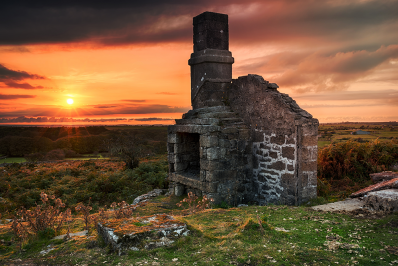Chimney Breast Removal: Structural Engineer & Building Regulations




Removing a chimney breast can free up valuable space in older homes and potentially increase their value. However, it's not a DIY job and involves understanding planning permissions, building regulations, and maintaining the structural integrity of your home.
- Chimney breasts are common in older properties and their strategic removal can genuinely increase the value of your house by creating more usable space.
- Removing a chimney breast often requires various approvals, including planning permission, adherence to building regulations, and importantly, agreements with your neighbours if it's on a party wall.
- The removal process is complex and poses significant structural risks; it should never be a DIY project. You must instruct a qualified Structural Engineer to design and oversee the work, ensuring full compliance with building regulations.
Is it a good idea to remove a chimney?
If you've bought an older house, you may be considering removing the chimney breast. While they are a historic feature, many homeowners consider removal to gain extra space, thereby improving the layout and functionality of their rooms.
Older buildings generally have a chimney, breast, and fireplaces designed to allow smoke to escape. In contrast, new homes are often built without chimneys, as the space is better utilised within living areas and bedrooms, reflecting modern design preferences.
Does removing a chimney breast add value to the property?
Depending on how you utilise the newly created space after removing a chimney breast, this project can increase the value of your property by potentially tens of thousands of pounds (£1,000s).
The additional usable floor area, improved room layout, and enhanced aesthetic appeal can also be significant selling points, making your property more attractive to potential buyers.
Common reasons for chimney breast removal
- Maximising Space: Chimney breasts can intrude into a room, particularly in smaller properties. Their removal creates valuable extra floor space, making rooms feel larger and more open.
- Improved Layout: The removal allows for more flexible furniture arrangement and the creation of more functional room layouts, which the presence of a chimney breast might otherwise hamper.
- Aesthetic Appeal: Removing a chimney breast can provide a cleaner, more modern aesthetic, especially if the fireplace is no longer used; it improves the overall flow of a room.
- Renovation Projects: As part of a larger renovation or extension, removing a chimney breast can facilitate new designs or the reconfiguration of internal spaces.
- Structural Issues: In some cases, a chimney breast might be suffering from structural problems (e.g., damp, cracks, leaning stack), making its removal a necessary step to ensure the property's integrity.

Call or send us a message to request a callback or an email answering your queries about our surveys. Our UK-based survey team can help you choose the right level home survey for your property, at no extra charge.
There's no obligation to instruct. We'll make sure you understand your options and provide a free, fixed-fee quote for our best-value survey to meet your needs. No robots, no call centres. Property challenges solved.
How do I know if a chimney breast has been removed?
The best place to check if a chimney breast has been removed is within the roof space. You can typically spot where the chimney stack comes into the property and measure its width at that point. If it appears smaller or missing below, it indicates a removal.
Most removals are visible in the roof and loft space. If it's not visible there, you can trace its path vertically through the property to the ground floor, as the chimney breast width should generally remain consistent. Discrepancies often point to a partial removal below.
Do I need a structural engineer to remove the chimney breast?
You will always require the services of a qualified Structural Engineer if you intend to remove a chimney breast. A chimney breast forms a fundamental part of a house's basic structure, and utmost care must be taken in your preparations before any work is carried out.
If you don't involve an expert, you risk serious structural degradation to your property, which could result in the building collapsing and even pose a risk to life.
Unless you're removing the entire chimney, from the lowest fireplace right up to the roof stack, you'll need suitable support beams to bear the weight of any masonry above. This prevents structural distress, damage, or even the collapse of the building.
As you can see from the diagram below, the breast acts as a hollow pillar from the ground up, often lending support to the upper floors and roof.
You'll also have to take special care if the chimney breast of an upper floor is going to be removed while leaving a working fire in the room below. Partial removal is possible, but a smaller chimney breast for the fire below must be left in place.

Removing Chimney Breast Party Wall
It's very common for your chimney to be located on a party wall, which is a wall shared with a neighbouring property.
If this is the case, removing a chimney breast is considered a major process under the Party Wall Act 1996 and has significant implications for both costs and time.
You will be legally required to serve a Party Wall Notice on your neighbour(s) and obtain a Party Wall Agreement for chimney breast removal before any work can commence.
This is a crucial step to protect both your interests and your neighbour's, preventing potential disputes. We can help with this service and guide you through the process.
How to remove a chimney breast
Once you instruct a structural engineer, they will examine the chimney breast in your property. Following this assessment, they will draw up designs and create an appropriate method of work for the job, ensuring structural integrity and safety.
They then submit both these designs and the methodology to your local Building Control Office for chimney breast removal approval.
If you're removing a chimney breast on a party wall, the Party Wall Act 1996 mandates that you'll also need to formally inform your neighbour(s) and obtain their written approval (a Party Wall Agreement) for your work.
Once your structural engineer's proposal has received approval, all work must be carried out precisely according to the approved designs.
Your local building control officer must be invited to inspect the work as it progresses and upon completion. The local Building Control Office will, upon satisfactory completion of the work, issue a completion certificate.
You must safely keep the building control completion certificate for your chimney removal with your property's deeds or Land Registry documents. This certificate is crucial for any future remortgage or sale of your property.
You'll also need to take special care if the chimney breast of an upper floor is going to be removed while leaving a working fire in the room below. Partial removal is possible, but a smaller, structurally sound chimney breast for the fire below must be left in place to support the flue above.
Finally, once you've successfully removed your chimney breast, you'll need to repair the floor where the breast once stood – this final stage also requires careful planning and involves additional costs.
What permission do you need to remove a chimney?
Do you need building regs to remove the chimney breast?
Your Structural Engineer has to abide by the Building Regulations 2010 regarding chimney breast removal - and these, as stated, entail at least one inspection from a local Building Control officer - to ensure compliance regarding the following:
- Structural strength;
- Fire safety;
- Sound insulation;
- Maintenance of any neighbour's chimney;
- Damp prevention; and
- Ventilation to rooms.
Do you need planning permission to remove a chimney breast?
You are unlikely to require planning permission to remove the chimney unless your property is listed, or in a conservation area because removing the outer stack will change the appearance of the house.
You may wish to consult the Government's online planning portal just to be sure.
Can you remove a chimney breast without a party wall agreement?
One neighbour cannot just remove a shared chimney. As stated above, under party wall legislation in England and Wales, you need to get written consent from the owners of any affected neighbouring property before any work on removing it starts. Either neighbour may ask for consent to remove the chimney.
Can I remove a chimney without permission from the freeholder?
If your property is leasehold, you'll need to get the permission of your landlord in the form of a licence, for which you may have to pay a fee.
Taking out a chimney breast when you have a gas boiler
Sometimes, your gas appliances make use of a party wall's flue in your property or your neighbour's property. You should ideally get a Gas Safe Engineer to inspect the appliance and get a proof of inspection and safety in writing (this can also be added to your store of essential house documents needed if you choose to remortgage or sell up).
Should you choose to remove your chimney stack where it goes through the roof, you'll need to extend the roof timbers to fill the gap and use matching roof covering.
Why are chimneys such a big deal?
Looking at ruins in places like Bodmin, or countless other similar sites, you can often see the entire chimney remaining upright long after the rest of a building has collapsed.
In the example below, the large stone chimney has kept the gable wall upright, even though nothing else remains of the house.
This highlights why chimneys are often fundamental to a building's structural integrity, and is precisely why a structural engineer must be involved in any chimney breast removal.

How much does it cost to remove a chimney breast?
On average, you might look to pay £1,500 – £2,100 for removing a 1st-floor chimney breast, and the job might take approximately three days.
You will also need to factor in the cost of a Structural Engineer, which is likely to be in the £300 - £700 range, depending on the complexity of the work involved and detailed calculations required.
For an entire chimney breast removal, while leaving the stack intact, you might expect to pay around £2,200 – £2,800. If you decide to get the stack removed as well, you can anticipate paying a further £1,000 to £1,700 for a professional job.
So, for a hypothetical semi-detached house, if you wanted to get a whole chimney, breast, and stack removed and ensure it is done in a legally compliant and structurally sound way (i.e., by instructing a structural engineer to produce drawings and manage approvals), you are likely to have to pay something in the region of £3,500 – £4,500 in total.
Please note these are averages and can vary based on location (e.g., London often has higher costs) and specific project complexity.
Our fee for a Structural Engineer Survey for a Chimney Breast Removal starts at £656 INC VAT.
Andrew started his career in 2000 working within conveyancing solicitor firms and grew hands-on knowledge of a wide variety of conveyancing challenges and solutions. After helping in excess of 50,000 clients in his career, he uses all this experience within his article writing for SAM, mainstream media and his self published book How to Buy a House Without Killing Anyone.
Caragh is an excellent writer and copy editor of books, news articles and editorials. She has written extensively for SAM for a variety of conveyancing, survey, property law and mortgage-related articles.









